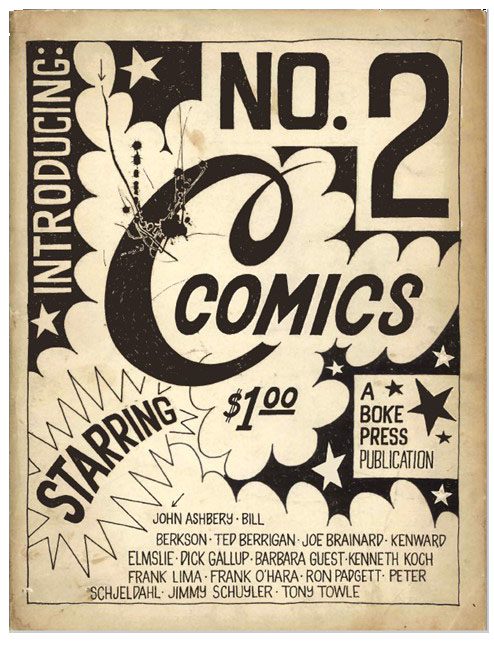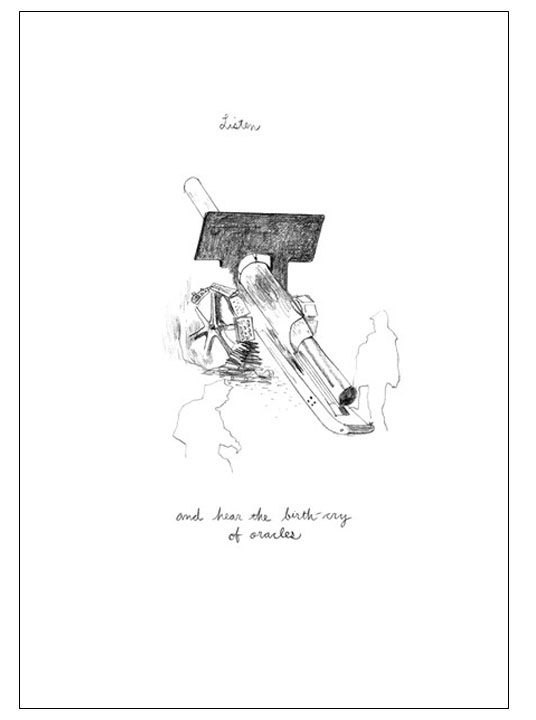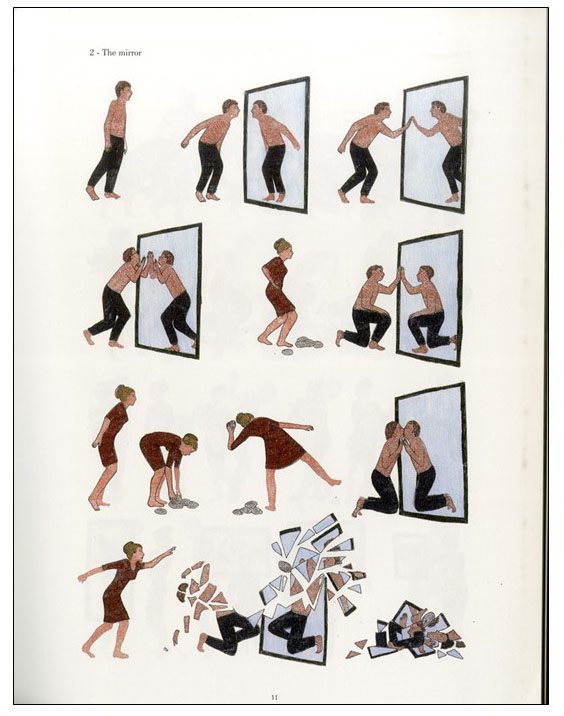The New York Comics & Picture-Story Symposium is a weekly forum for discussing the tradition and future of text/image work. Open to the public, it meets Tuesday nights 7-9 p.m. EST in New York City. Presentations vary weekly and include everything from historical topics and technical demonstrations to creators presenting their work. Check out upcoming meetings here.
The 115th meeting of the NY Comics & Picture-Story Symposium was held on Tuesday, February 17th, 2015. Alexander Rothman presented “The Comics Poetry Toolbox.” Artist and cartoonist Archie Rand presented his Psalm 68 project and other poetry-image works. Our review of Mr. Rand’s presentation will appear in this column next week.
***
Comics poetry! At first a strange-sounding phrase, but an increasing number of literary people have come to compare, if not equate, comics with poetry. Presenter Alexander Rothman chooses the words “comics poetry,” and defines, in his presentation “The Comics Poetry Toolbox,” what it is, and how cartoonists have used it.
What is comics poetry?
First, what is poetry? Many things are categorized as poetry, but they are so diverse that they seem unrelated: sonnets, concrete poetry, Haiku, slam performances, and so on. What binds these forms together is their common origin in the oral tradition, involving rhythms, rhymes, and even mnemonic devices. Rothman insists it is the taking and tweaking of a language that is at the heart of poetry, where language is the very medium itself. The e.e. cummings poem “l(a” is a great example:
l(a
le
af
fa
ll
s)
one
l
iness
What is comics? is also a complicated question. According to Rothman, comics is a medium that treats images like language. Is it possible to turn visual language into what we’ve just defined as poetry? Several publications indexed below (some discovered in the graphic novels collection of the Columbia University library), do just that.
(some discovered in the graphic novels collection of the Columbia University library), do just that.
C Comics No. 1 (Lorenz Gude, 1964) is filled with collaborations between Joe Brainard and New York School poets. This rare and long out-of-print publication assumes readers will have a command of the comics vernacular. “What to Do,” a seven-page story by Brainard and James Schuyler from a play by Georges Feydeau, is essentially clip art with lots of text streaming in balloons down the pages. The story? Two people each having an affair with their house guest. (To resolve this, the woman suggests a menage a trois.)
C Comics No. 2 (Boke Press, 1965) is the second and last issue of C: Comics, and boasts a cover using two well known elements of comics, the display-lettered sound effect, and the caption in bursts. Pow! The six page story “Forehead,” by Barbara Guest and drawn by Brainard, employs the traditional comic thought balloon, with the occasional star motif and panel grid. Its visual content, though, hardly quotes comics at all. The illustrations consist of traditionally (and beautifully) drawn animals and even a fine-art quotation, from The Valpinçon Bather by Ingres. In this sense, this story can be seen as the forerunner of today’s more illustrated graphic novels—non-comic art, but in a comic art setting.
On the other hand, “Pay Dirt,” by Brainard and Kenward Elmslie, is brimming with comics motifs and graphics in a style that reminds one of the cartoonist Skip Williamson. “People of the World Relax!,” by Brainard, features appearances by Dick Tracy, Zero from Beetle Bailey, Dennis the Menace, and Jiggs from Bringing Up  Father. Captions shout “Take it easy!,” “Smoke a lot!,” “The world is yours, take it!,” “Don’t be afraid to die!,” and, of course, “Relax!” The author’s message is abundantly clear.
Father. Captions shout “Take it easy!,” “Smoke a lot!,” “The world is yours, take it!,” “Don’t be afraid to die!,” and, of course, “Relax!” The author’s message is abundantly clear.
How To Be Everywhere (self-published, 2007), which Warren Craghead credits to himself and Guillaume Apollinaire, presents story graphics that are not in sequence, but, rather, simultaneous. Of course, this is heresy to those of us who’ve always defined comics as a sequential medium. In “Raining,” written text streaks down the page like rain down a wall. Elsewhere, text stretches out like a high cubist composition and faces, on the next page, a Robert Delauny painting of the Eiffel tower.
How To Be Everywhere begins by declaring Europe to be a great center of culture (“I am the gullet of Paris if it pleases me I will swallow ALL OF CREATION”) and then concludes with the collision of Europe with modernity, namely, World War I. One image is of a field cannon, with text hand-written: “I am in the front line trenches and…just beginning to be everywhere. Listen and hear the birth-cry of oracles.” In the end, we see a bandaged soldier saying “I bequeath to the future the story of Guillaume Apollinaire, who was in the war, and knew how to be everywhere.”
 Education, by John Hankiewicz (self-published, 2014), in contrast to many other comics in this survey, tells its narrative conservatively and stays within the grid, but uses some interesting devices. Four to six panels on a page carry what Rothman calls visual rhythm. Our central character has moved from Chicago to Arkansas to teach college English and has encounters with a number of friends, colleagues, and family members. There are notable silent sequences and passages that alter the tempo of the story. Sometimes the text floats, detached, above the picture. Some sequences repeat whole pictures, but with changing dialogue. A star motif reappears throughout the text. Most memorable are the scenes in an abandoned rail station, one in which the hatching that has carried the book’s gray tones morphs into a chain link fence, and a haunting moment where a maple seed pod floats to the ground in its familiar helicopter fashion.
Education, by John Hankiewicz (self-published, 2014), in contrast to many other comics in this survey, tells its narrative conservatively and stays within the grid, but uses some interesting devices. Four to six panels on a page carry what Rothman calls visual rhythm. Our central character has moved from Chicago to Arkansas to teach college English and has encounters with a number of friends, colleagues, and family members. There are notable silent sequences and passages that alter the tempo of the story. Sometimes the text floats, detached, above the picture. Some sequences repeat whole pictures, but with changing dialogue. A star motif reappears throughout the text. Most memorable are the scenes in an abandoned rail station, one in which the hatching that has carried the book’s gray tones morphs into a chain link fence, and a haunting moment where a maple seed pod floats to the ground in its familiar helicopter fashion.
In Pieces (Nobrow, English Ed., 2013), by Marion Fayolle, has no panel borders, but the images that make up a page are as clear and readable as any graphic novel. Elegantly painted characters, some drawn with rubber stamps with marker and ink, go through clever pantomime sequences with ironic twists. There are four tiers on a page that remind one of Eadweard Muybridge’s photo motion sequences. The funniest are “The [Broken] Mirror,” with its continuation “Three Fragments,” and a three-parter, “Lifted,” “The Innocent,” and “The Thug,” in which a man’s mannequin-like arm falls off and causes all sorts of trouble (one character picks up the arm and then gets shot, and another uses it in a baton in a relay race).
Elegantly painted characters, some drawn with rubber stamps with marker and ink, go through clever pantomime sequences with ironic twists. There are four tiers on a page that remind one of Eadweard Muybridge’s photo motion sequences. The funniest are “The [Broken] Mirror,” with its continuation “Three Fragments,” and a three-parter, “Lifted,” “The Innocent,” and “The Thug,” in which a man’s mannequin-like arm falls off and causes all sorts of trouble (one character picks up the arm and then gets shot, and another uses it in a baton in a relay race).
The most allegorical story in In Pieces is called “The Cage,” wherein a woman wearing what looks like the frame of an antebellum hoop skirt encounters a potential suitor, who climbs in. Another man shows up, sees that the girl’s cage is already occupied, and walks away heartbroken, proving that, whatever method the poet or cartoonist uses, universal human experiences are still the most familiar, and eternal, subject matter.
***
Watch a video of Alex Rothman’s presentation below (or click here):
***
Image credits:
Image 1: Cover, C Comics #2, by Joe Brainard (Boke Press © 1965)
Image 2: How to be Everywhere, by Warren Craghead and Guillaume Apollinaire (self-published © 2007)
Image 3: Education, by John Hankiewicz (self-published © 2014)
Image 4: “The Mirror,” In Pieces, by Marion Fayolle (Nobrow, English edition © 2013)
***
Alexander Rothman is a cartoonist and poet whose work has appeared in venues including The Indiana Review, Drunken Boat, The Brooklyn Rail, and š! He is publisher and co-editor-in-chief of Ink Brick, a micro-press dedicated to comics poetry, and he cohosts Comics for Grownups, a review podcast available on iTunes. See more of his work at inkbrick.com.
***
About the author: Mark Lerer holds a bachelor’s degree from Princeton University and an MFA from the New York Academy of Art. His cartoon drawings have been published in the New York Post, and have appeared at New Century Artists and Nexus galleries, and are regularly featured on Facebook.




